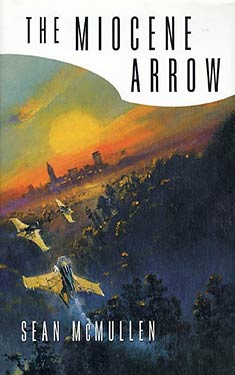
Added By: valashain
Last Updated: Administrator
The Miocene Arrow
| Author: | Sean McMullen |
| Publisher: |
Tor, 2000 |
| Series: | Greatwinter: Book 2 |
|
0. Mirrorsun Rising |
|
| Book Type: | Novel |
| Genre: | Science-Fiction |
| Sub-Genre Tags: | |
| Awards: | |
| Lists: | |
| Links: |
|
| Avg Member Rating: |
|
|
|
|
Synopsis
Sean McMullen is one of the hottest new writers working today. He is a three-time winner of the Ditmar Award in his native Australia, and has also won that country's Aurealis Award. His last novel, Souls in the Great Machine, began the steampunk saga of Greatwinter and garnered him much critical acclaim. The Miocene Arrow continues McMullen's story of a far-future Earth flung back to its pre-technological roots.
Ultra-light American diesel gunwings can hold their own against Australian human-powered battle computers and a tram-based net. But they are helpless against the ultimate doomsday machine: The Miocene Arrow.
In a fortieth-century America of ancient kingdoms with opulent courts, hereditary engineering guilds, and rigid class distinction in warfare, a centuries-old balance of power is shattered by a few dozen Australian infiltrators. Against a rich backdrop of war, chivalry, conspiracy, and a diesel-powered arms race, a dangerous secret alliance has formed. Now the unlikely trio of an airlord, an abbess, and a fugitive are joined together in a desperate race against time to stop the Miocene Arrow from being launched--and save the world in the process.
Excerpt
1
CORONATION
5 May 3960: Condelor
It was said that no dominion in Mounthaven did coronations and funerals so well as Greater Bartolica. In area it was the biggest of the dominions and Condelor, its beautiful and ancient capital, was the most elegant of the known world's cities. The buildings that lined its streets were built proof against age as well as earthquakes, built with curving walls that tapered gracefully upward, as if striving to rise into the air. The windows were within heavy arches, but there were so many windows in each building that their interiors were never dark or oppressive. The apartment terraces, shops, and storehouses were all encrusted with multicolored stone and glazed tiles. Even the tiles on the roofs were glazed and colored, for it was important that Condelor also be pleasing to the wardens who saw it from the air. Raised aqueducts of sawn black basalt, orange sandstone, and red brick carried water in from the nearby mountains, where it passed down terracotta pipes to power machines before emptying into the canal waterways that interwove the roads and tramways of the city.
As one neared the center of Condelor the parks became bigger, the mansions were more splendid, and the streets and avenues grew wider until the royal palace came into view above the trees. It was built in parkland interlaced with canals, and to the south was the spacious palace wingfield that could accommodate the gunwings of hundreds of visiting wardens and airlords. Even the gunwing halls ofthe wingfield had stained glass in their arched windows, while the adjunct's tower was surrounded by flying buttresses and encrusted with winged gargoyles.
The coronation of Greater Bartolica's new airlord had attracted wardens and squires with over three hundred sailwings and gunwings, and the field guildsmen and their tents supporting the vast flock of wings had spilled out of the wingfield area and into the surrounding parks. Ground crews could be seen pushing aircraft of every airworthy shape imaginable along the avenues to reach the guild tents where they were to be serviced, tuned, and cleaned. Freelance engineers advertised and displayed their valves, cylinders, rings, bearings, and atomizers at stalls on the mosaic sidewalks. Compression spirit of many caloric blends was available from carts laden with barrels, while other carts carried little steam engines to spin compression engines into life. Freelance gunsmiths did a particularly good trade. The best reaction guns were sold in pairs and were built light--like everything else that had to fly.
Quite apart from its most obvious objective, the coronation was a celebration of travel and class distinction. In fact speed of travel defined Mounthaven society, and one's social status defined whether one had taken months or hours to reach Condelor. At the lowest levels, itinerant workers, poor scholars, outlaws, trappers, and bounty hunters traveled the trails by foot. Such travel was slow and dangerous, but free. At the next level, the farmhands, birdherders, and townsfolk never traveled more than ten miles from where they were born, but they were generally secure and happy, and never attended coronations. The merchants, artisans, and other respectable folk traveled on the steam trams, whose mesh of trackwork linked all the important cities, towns, and estates. The trams were regular and well guarded, but crowded and expensive, and averaged barely three times the pace of a brisk walk. Fuel, raw materials, and equipment were also moved by tram, which meant that everything was expensive unless produced locally. Mostestates were self-sufficient, and few cities were bigger than a half-day journey with a farm handcart.
The nobility flew. Airlords, wardens, squires, and a few select guildsmen flew the sailwings, regals, and gunwings that defined the aristocracy. No part of Mounthaven was more than a few hours away from any warden's estate, but even a flock of three or four wings required an estate of two hundred to support, maintain, and fuel them. A new aircraft cost what a prosperous commoner could earn in two decades. Wardens patrolled the land during Calls, fought duels and highly stylized wars, attacked renegade militia strongholds, and monopolized fast communication and travel. The wardens were visible to all, and in turn saw, taxed, and controlled everyone beneath. them. They were also free of the Call while in the air. While in many ways less than perfect as political systems went, it had endured since the reinvention of diesel compression engines over a thousand years earlier.
Serjon Feydamor was the lowest of the flying elite, an apprentice guildsman and trainee flyer. The Yarronese youth wore a plain green flight jacket as he explored the multitude of stalls of what might easily have been mistaken for an artisans' festival. On the right and left of his collar he also wore silver flyer blazons signifying that he was qualified to fly armed sailwings in the service of his airlord. He had the crest of his engineers' guild on his cap, but his cap was folded up and hidden in his pocket. Occasionally he was hailed as a squire by the vendors, and each time his heart flushed warm with pride.
Serjon was in a very curious position. After having sired several daughters but no sons, the guildmaster Jeb Feydamor had petitioned his wife and his warden under the tradition of assisted succession. Under this custom, Warden Jannian visited Jeb's wife for several weeks until she became pregnant by him. Were the child another girl, the warden's youngest son would become the nominal heir of the Feydamor guild family. As it happened, Serjon wasborn of the union, yet he was born with his true father's love of flying and was proving a poor apprentice engineer. In theory, if Warden Jannian and all his other sons were to die, then Serjon could lay claim to the wardenate. Even though he never wished such a disaster to happen, Serjon nevertheless considered himself to be a flyer. The thin, angular, and intense youth of nineteen wore his engineer's crest with reluctance and shame, and only when forced to.
The great gathering of aircraft was not open to the citizens of Condelor, who had to content themselves with merely watching the wings fly in from all points of the compass. Sailwings and gunwings of the Mounthaven wardens soared lazily through the sky while Serjon wandered the streets. They were elegant and stylish aircraft, whose form had often remained unchanged over centuries because their estate guildsmen had decreed that they had achieved perfection already.
There were more ceremonies than just the coronation, which was the actual focus for the gathering. The guildmasters of the engineers, airframists, fuelers, gunsmiths, and instrumenteers had meetings to refine standards, while wingfield adjuncts met to discuss wingfield administration, dueling and war protocols. Members of the guild of meteorologists discussed weather theory and precedent, squires met to arrange marriages for their children, weavers debated the virtues of the new crosswoven airframe silk that promised double strength, and the wardens themselves discussed flying. The competitions were already over, but pinned to Serjon's collar at his throat was a little gold starpoint kite that marked him as the winner of the sailwing division in target kite shooting. Every so often he would caress it, as if reassuring himself that he was born to fly.
Within the palace grounds the Inner Guard and ancillary carbineers all wore parade uniforms, bright, smart, and well tailored for the coronation. The instruments of the bands shone in the sunlight as they marched along theavenues playing bright, precise marches for the parades and processions, but by night string orchestras took over as the nobles and their wives, sons, and daughters danced in the brightly painted and tapestry-laden halls of the palace. An airlord from Senner had once said, "We go to Condelor to fall in love, and to remember how to live." To Serjon, however, the Condelor gathering was an excuse to hide his cap in his pocket and mingle among strangers as a flyer.
Serjon's wanderings had taken him to the palace wingfield when a Calltower bell began ringing. He immediately went to a public rail and clipped his tether to it, then waited to watch the duty warden ascend for his Call patrol.
The duty warden of the palace wingfield heard the ringing of the Calltower bell as he was breakfasting in the adjunct's chambers. Even as he looked up, the guildsmen of his ground crew began shouting to each other. Moments later the compression engine of his sailwing spluttered into life as his engineers spun it with a steam engine on a cart. The warden stood up, buttoned his jacket, then took a steamed towel from his aide and wiped his face and hands. His flight jacket was a blaze of gold thread embroidery on blue and yellow silk quilting, with gilt epaulettes of dirkfang cat skulls and red gemstones inset within each button. Standing in front of a full-length mirror, he pulled on his leather and felt cap with raised domes of giltwork over the ears, laced it tight, then picked up his tassel-fringed gloves. Finally his aide brought a gold cloak with his estate's crest embroidered on the back, and Warden Brantic strode from the room out onto the wingfield.
Along with Serjon there were hundreds of foreign dignitaries outside waiting to watch the warden ascend, ranging from senior wardens to mere merchants. Serjon should have felt pride burning through his body, knowing that even the wealthy merchants alongside him were below a flyer in peerage status, yet something was nagging at hismind. Warden Brantic's flight designator was 13. Serjon stared at the number as if it were a large and dangerous predator, fearful for the warden yet relieved that someone else was about to step into its cage.
Most of the onlookers were in national parade dress, guild uniforms, or their own splendid flight jackets. There were so man...
Copyright © 2000 by Sean McMullen
Reviews
There are currently no reviews for this novel. Be the first to submit one! You must be logged in to submit a review in the BookTrackr section above.
Images
No alternate cover images currently exist for this novel.



















 Full Details
Full Details






